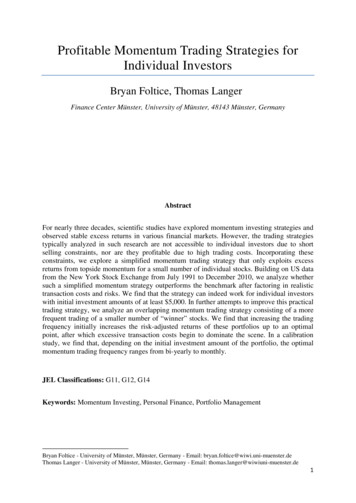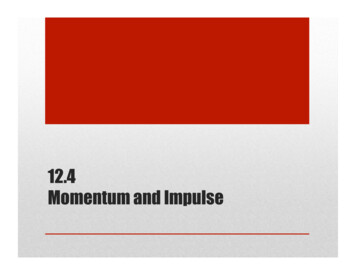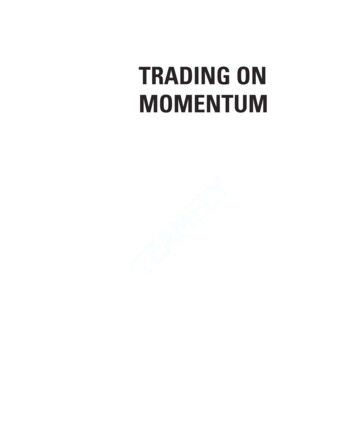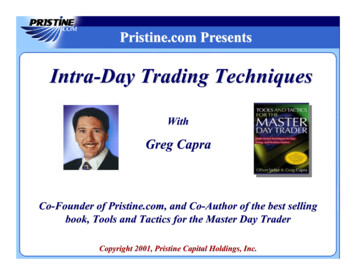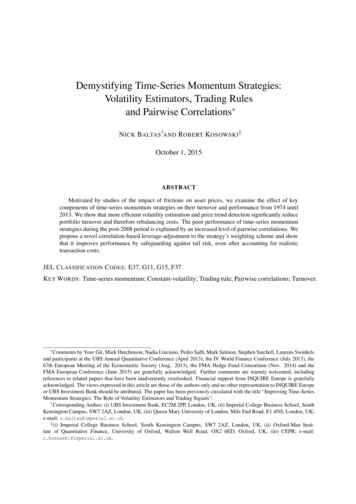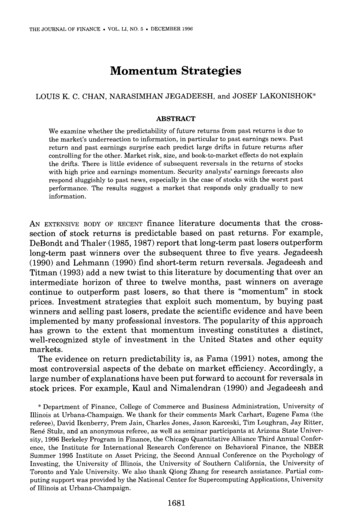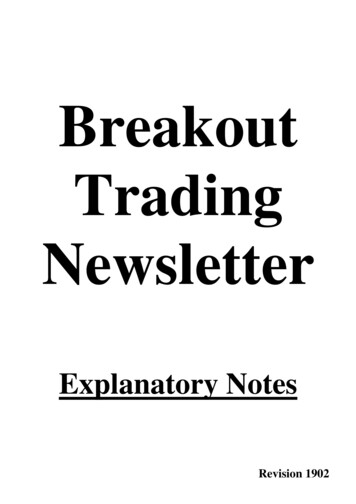
Transcription
The profitability of momentum trading strategies: A comparisonbetween stock markets in the Netherlands and GermanyOliver WeilMaster’s Thesis International Financial Management (Double Degree)University of Groningen and Uppsala UniversityAbstract: Can momentum trading strategies beat Dutch or German stock market indices? If so, dothose strategies show significant positive net returns? For the period from March 2009 to March 2016this appears to be the case for only one out of the nine momentum trading strategies investigated withrespect to the Dutch stock market and for none of those same momentum trading strategiesinvestigated with respect to the German stock market. Furthermore, this research finds that the netmomentum returns seem to be winner- instead of loser-portfolio driven and that the longer the holdingperiod, the higher the net momentum returns realized.Keywords: Momentum, Efficient markets, The Efficient Market Hypothesis, Transaction costsJEL classifications: G10, G11, G14, G15, G19Author:Mail:Phone number:Student number:Study program:Place and date:Supervisor:O. A. M. Weiloam.weil@gmail.com 31 610155762s2021277DD MSc International Financial ManagementGroningen, June 2nd 2017Prof. dr. B. W. Lensink
I. IntroductionManagers as well as investors are continuously trying to find ways in which they can generatesignificant returns. In an efficient market - a market in which security prices always fullyreflect available information - the true expected return on any security is equal to itsequilibrium expected value, which is, of course, also the market's assessment of its expectedvalue (Fama 1965, 1970). Although the efficient market hypothesis has been tested widelyand generally has been found consistent (Jensen, 1978), around the late 1970s, systematicdeviations from theoretical expectations, so-called anomalies, were discovered (Frankfurterand McGoun, 2001). These anomalies open up the possibility of profit opportunities by usingtrading strategies. Research on trading strategies that go against the efficient markethypothesis distinguishes between contrarian trading strategies and momentum tradingstrategies. This paper focuses on momentum trading strategies. A momentum trading strategyis based on stock price momentum. The underlying expectation is that past stock performancewill continue into the future. In other words, stock prices that have appreciated in the past willcontinue doing so in the future. The same applies to stock prices that have decreased in thepast; the momentum trader assumes that they will continue doing so in the future. Making useof the anticipated price trend, a momentum trading strategy involves stocks which haveperformed well in the past, expecting that a positive return will be made when those stocks aresold at a later date. In the same manner, a positive return is expected to be made by themomentum trader when he short sells stocks1 that have decreased in price in the past.With respect to the momentum trading strategies the debate continues about what causes themomentum returns and, on the other hand, about whether the momentum strategy is trulyprofitable. With regard to the cause of the abnormal momentum returns, Fama and French(1996), Grundy and Martin (2001) and Jegadeesh and Titman (2001), show that rationalmodels fail to explain them. Since the rational models fail to explain the abnormal momentumreturns, researchers introduced the so-called behavioral models. According to Barberis andShleifer (2003), Daniel et al. (1998) and Hong and Stein (1999), the behavioral models statethat abnormal returns that arise due to a momentum trading strategy occur because ofincorrect or delayed information interpretation by the investors. Discussion concerning theprofitability of the momentum strategy focuses on the assumptions with respect to the true1Short selling is the sale of a stock that is not owned by the seller. It is driven by the assumption that a stock’sprice will decrease, enabling it to be purchased back at a lower price to make a profit.2
transaction costs involved in pursuing such a strategy. Jegadeesh and Titman (1993, 2001)find abnormal returns for the momentum trading strategy by taking into account 0.5%transaction costs. However, more recently, many researchers consider a 0.5% transaction costtoo low when pursuing a momentum strategy (Agyei-Ampomah, 2007; Korajczyk and Sadka,2004; Lesmond et al., 2004; Pavlova et al., 2011).Previous literature investigated whether momentum returns existed in the United States, theUnited Kingdom and internationally (e.g. De Bondt and Thaler, 1985; Doukas and McKnight,2005; Griffin et al., 2003; Jegadeesh and Titman, 1993). To my knowledge little momentumstrategy research has been done with respect to continental Europe.This paper focuses on the profitabilities (on a net basis) of momentum trading strategies withrespect to the Dutch and German stock markets from March 2009 to March 2016 (hence, afterthe financial crisis of 2008) and also attempts to make a comparison between thoseprofitabilities.This paper seeks to answer two research questions.The first question is:Can a momentum trading strategy yield significant positive net returns in the Netherlandsthat exceed the AEX index?The second question is:Can a momentum trading strategy yield significant positive net returns in Germany thatexceed the MDAX index?The answers to these research questions add to the existing literature in several ways. First,this paper contributes to existing literature by analyzing a new time period (2009-2016), thusavoiding any distortions in the results caused by the financial crisis of 2008. Second, Iinvestigate the profitability of momentum trading strategies in continental Europe, morespecifically in the Netherlands and Germany. So far, most momentum trading strategyresearch has focused on the US and UK stock markets. Third, when calculating the netprofitability of the various momentum trading strategies, I endeavor to approximate the actualtransaction costs as closely as possible in order to determine whether the application of3
momentum trading strategies is advantageous. Fourth, I investigate if, and to what extent, theprofitability (on a net basis) in the Netherlands exceeds the Dutch stock market AEX indexand if, and to what extent, the profitability (on a net basis) in Germany exceeds the Germanmidcap stock market MDAX index. Finally, I investigate the profitability of momentumtrading strategies (on a net basis) not only for the research period, but also with respect to sixconsecutive 12-month periods within the research period. This part of the research aims atproviding insight in the development of the profitability of the various momentum tradingstrategies during the research period.The results of this research show that, while in the Netherlands five out of the ninemomentum trading strategies investigated yield a positive net return that is higher than theDutch stock market AEX index, in Germany only two out of the corresponding ninemomentum trading strategies investigated yield a positive net return that is higher than theGerman midcap stock market MDAX index. However, only one out of the five Dutchmomentum trading strategies that beat the market, yields a significant (positive) net return,while neither of the two corresponding German strategies that beat the market, is robust. Withrespect to all nine Dutch and German momentum trading strategies, the major part of the netmomentum returns, when calculated over the research period, can be attributed to the winnerportfolio. With respect to all nine Dutch and corresponding German momentum tradingstrategies this research shows that the longer the holding period, the higher the net momentumreturns realized. For seven out of the nine momentum trading strategies the net momentumreturns realized in Germany are lower than the ones realized in the Netherlands, even thoughfor all nine momentum trading strategies applied, the German gross returns are higher than theequivalent Dutch gross returns. Finally, this research shows that for all nine momentumtrading strategies the transaction costs in Germany are quite a bit higher than those in theNetherlands. However, the difference between the Dutch and German transaction costs seemsto decrease as the length of the holding periods increases.The remainder of this paper is organized as follows. Section II examines the literature ontrading strategies and, more in particular, about momentum strategies. Section III describesthe data and methodology used for this research. Section IV provides the empirical results thatare found and section V contains a number of conclusions. Finally, section VI provides thereference list and section VII consists of the Appendix.4
II. Literature reviewThis section contains an overview of the literature relevant for this paper. In section II.1 theefficient market hypothesis versus the contrarian and momentum trading strategies isdiscussed. In section II.2 the profitability of the momentum trading strategy is discussed.Section II.3 focuses on the causes of momentum profits and section II.4 reviews the literatureon the correlation between Dutch and German stock market returns and between Dutch andGerman stock market indices.II.1. Efficient market hypothesis versus the contrarian and momentum trading strategiesThe efficient market hypothesis is an important theory in the world of finance and is used asstarting point in much academic research. As mentioned before, in an efficient market, stockprices fully reflect available information (Fama 1965, 1970). The efficient market actuallystates that one cannot predict potential returns by making use of past data. Simply said, in anefficient market stocks trade at their fair value, which leads to the situation that it isimpossible for managers and investors to either buy stocks that are undervalued or sell stockswhich are overvalued. In other words, managers and investors cannot beat the market. Only inan inefficient market will the true expected returns and equilibrium expected returns notnecessarily be identical (Fama, 1976). However, around the late 1970s, systematic deviationsfrom theoretical expectations were discovered; that is, there appeared to be predictableopportunities for earning abnormal returns using rather simple trading strategies (Frankfurterand McGoun, 2001). These deviations were labeled anomalies. Anomalies are empiricalresults that seem to be inconsistent with maintained theories of asset-pricing behavior(Schwert, 2003). They show either market inefficiency (profit opportunities) or inadequaciesin the underlying asset-pricing model. After they are recognized and studied in the academicliterature, anomalies frequently seem to vanish, reverse, or decrease. This raises the questionwhether profit opportunities existed historically, but have since been arbitraged away, orwhether the anomalies were simply statistical deviations that attracted the attention ofresearchers (Schwert, 2003).There have been many papers that tried to confirm the profitability of trading strategies thatfocus on the predictability of stock returns (Kothari, 2001). For instance, Fama and French(1995) report evidence on the book-to-market effect, De Bondt and Thaler (1985, 1987) reporton the long-term contrarian effect, Jegadeesh and Titman (1993) and Rouwenhorst (1998)5
report on the short-term momentum effect, Moscowitz and Grinblatt (1999) looked at theindustry-factor effects to explain the momentum effect, Chan et al. (1996) research the use ofthe momentum strategy for the US stock market, while Griffin et al. (2003) show that amomentum strategy yields abnormal returns in international stocks. These articles all analyzethe contrarian or the momentum strategy as trading strategies that rely on stock marketanomalies.In academic literature two trading strategies may be distinguished, the contrarian tradingstrategy and the momentum trading strategy. Where the contrarian trading strategy involvesbuying historical “losers” and selling historical “winners”, the momentum trading strategyinvolves buying historical winners and selling historical losers. One of the most importantarticles that confirmed the existence of the contrarian trading strategy for the US stock marketis the article by De Bondt and Thaler (1985). They show that, over a three to five year period,past winner stocks are outperformed by past loser stocks and therefore they suggest to buy thehistorical losers and sell short the historical winners. This contrarian trading strategy wasconfirmed by, amongst others, Jegadeesh (1990) and Lehmann (1990), who show that thecontrarian strategy holds not only for a period of three to five years, but also for a muchshorter time period, namely, a week or a month. Besides the contrarian trading strategy, themomentum trading strategy also contradicts the efficient market hypothesis. One of the mostimportant articles that confirmed the existence of the momentum trading strategy is the one byJegadeesh and Titman (1993). These authors show that buying stocks that performed wellhistorically (three to twelve months) continued to perform well during the next three to twelvemonths. Within these next three to twelve months, the stocks appear to have a “momentum”that triggers them to keep going in an unchanged direction. The authors demonstrate thatabnormal returns can be made by going short on a portfolio consisting of historically losingstocks in a certain period and taking a long position in a portfolio consisting of historicallywinning stocks in an equal time period. Therefore, they suggest short selling the historicallosers and buying the historical winners. In the article by Jegadeesh and Titman (1993), thestocks are ranked based on their returns in the previous ‘J’-months. The formation period,which is also known as the evaluation period or the ranking period, is the period that thestocks are ranked (this period consists of J-months). In the article by Jegadeesh and Titman(1993) J varies between three, six, nine and twelve months. They chose to construct theportfolios in such a way that the winner portfolio consisted of the best performing stocks (topten percentile) and the loser portfolio consisted of the worst performing stocks (bottom ten6
percentile). After the portfolios were constructed, they had to be held for a period of ‘K’months (again; three, six, nine and twelve months), which is named the holding period.Jegadeesh and Titman (1993) conclude that they find significant returns of 1.1% per month.Not only Jegadeesh and Titman (1993) confirmed the momentum trading strategy to beprofitable in the United States, also Chan et al. (1996) did so. Jegadeesh and Titman (2001)evaluated the research they had undertaken approximately eight years earlier and found thatthe momentum trading strategy continued to be profitable in the United States for the periodfrom 1990 to 1998. Furthermore, Rouwenhorst (1998) shows that also in Central Europe themomentum trading strategy generates significant positive returns. With respect tointernational stocks, Moskowitz and Grinblatt (1999) and Griffin et al. (2003) show that themomentum trading strategy generates significant positive returns in financial markets all overthe world. More recently, Moskowitz, Ooi and Pedersen (2012) and Asness, Moskowitz andPedersen (2013) find that momentum occurs in exchange traded futures contracts and inbonds too.II.2. Profitability of the momentum trading strategyMany researchers showed that pursuing a momentum strategy and thereby taking into accounttransaction costs of 0.5% per trade generated significant positive returns (Jegadeesh andTitman, 1993, 2001; Liu et al., 1999; Rouwenhorst, 1998). They came to this 0.5% transactioncost by taking an average transaction cost. However, more recently, many researchersconsider a 0.5% transaction cost too low when pursuing a momentum strategy. AgyeiAmpomah (2007), Korajczyk and Sadka (2004), Lesmond et al. (2004) and Pavlova et al.(2011) consider a transaction cost of 0.5% to be too low, because regular portfoliorebalancing is needed in order to pursue a momentum strategy. One must buy the winnerstocks and sell short the loser stocks every time the formation period (consisting of J-months)ends. This comes with transaction costs that, according to the previously mentioned literature,should be higher than 0.5%. Lesmond et al. (2004) even go as far as to state that a momentumstrategy is not profitable at all when taking into account the necessary substantial transactioncosts. This is also shown by Pavlova et al. (2011), who find that the profits of the momentumstrategy vanish entirely when fully taking into account the costs of trading. On the other hand,Korajczyk and Sadka (2004) consider that, although a transaction cost of 0.5% is too low tomaintain the momentum strategy, the momentum strategy is still profitable despite the highertransaction costs. Agyei-Ampomah (2007) show that the profitability of momentum strategies7
with formation and holding periods up to six months is impeded by high transaction costs.The high transaction costs are caused by the high portfolio turnover rate. However, the tradingintensity and associated costs of the momentum strategy decreases for longer formation andholding periods. Therefore, investors can profitably trade on momentum strategies withformation and holding periods of six months and more.II.3. What causes momentum profits?Although Lesmond et al. (2004), as well as Pavlova et al. (2011) clearly state that momentumprofits do not occur, many other academics firmly believe that profitable momentum returnsdo exist. These researchers are mainly interested in the cause of the momentum returns, tryingto explain the presence of these excess returns through either rational or through behavioralmodels.With respect to the rational models, Fama and French (1996) and Grundy and Martin (2001)show that asset-pricing models based on rationality fail to explain abnormal momentumreturns. Conrad and Kaul (1998) suggest that cross-sectional diffusion in expected returnscould be a valid source of the momentum returns. Jegadeesh and Titman (2001), however,claim that the findings of Conrad and Kaul (1998) are not the reason behind these profitablemomentum returns. MacKinlay (1995) argues that mainly data mining drives the momentumpremium, though Grundy and Martin (2001) and Jegadeesh and Titman (2001) reject hisfinding and state that his arguments do not completely give the explanation to momentumprofits.Since rational models were not able to explain the profitable momentum returns, behavioralmodels were introduced in order to find an explanation. Daniel et al. (1998) state that tradingbecause of biased self-attribution and overconfidence explains momentum investing. Theyargue that one will buy a stock if good news supports their own optimistic indication. Thisalso works the other way around; one does not sell the stock if the negative indication isinconsistent with positive news. Barberis et al. (1998) propose that under-reaction is initiatedby the conservatism bias over time horizons of one to fourteen months. They explain thisconservatism bias as holding on to previous opinions. Thus, investors underreact to the newinformation that is given, causing the effects of the information on the stock price to be late.More recently, Grinblatt and Han (2005) wrote that the disposition effect is the main reason8
investors underreact to information. They explain this effect as the trend of investors to sellshares of which the price has increased, while keeping the shares that have decreased in price.II.4. Correlation between Dutch and German stock market returns and between Dutch andGerman stock market indicesThe Netherlands and Germany have close economic, political, social and cultural ties.Economically, Germany is particularly important to the Netherlands. It is its main tradingpartner, not only for imports, but also for exports2. According to Eun and Resnick (1984),who examined multiple stock markets around the world, the stock market returns of Germanyand the Netherlands (and Switzerland) had the highest correlation. Furthermore, Bertero andMayer (1990) examined share price movements for 23 countries globally. Of the 23 marketsexamined they report four groups of countries whose stock market indices were particularlyclosely correlated. One of these groups consisted of Switzerland, Germany and theNetherlands. Likewise, Roll (1992), who examined 24 stock markets worldwide regarding thebehavior of international stock market indices, shows that the correlation between Germanyand the Netherlands is the highest (again, together with Switzerland). All these findingsclearly indicate that German and Dutch stock market returns and stock market indices arehighly en/betrekkingen-met-nederland/inhoud/duitsland (accessed on January19th 2017)9
III. Data and methodologyThis section contains the data and methods used in my research. Section III.1 provides anoverview of the framework of my research. Section III.2 explains the source of the data usedin my research. Section III.3 provides the research methods used to calculate the returns of themomentum trading strategy. Section III.4 provides the research methods used to calculate thetransaction costs and section III.5 provides the research method used to calculate correlations.III.1. Framework of this researchIn this paper I analyze the profitability of the momentum trading strategy with respect to theDutch and German stock markets. In this context I also compare the development of thoseprofitabilities. The research period runs from March 2009 to March 2016, thus avoiding anydistortions caused by the financial crisis of 2008. This paper makes use of the momentumtrading strategy method as developed by Jegadeesh and Titman (1993, 2001), but deviatesfrom their method as follows:First, with respect to the sample, while I copy their method for the Dutch stock market bytaking into account all the stocks listed on the Amsterdam Stock Exchange, I do not copy theirmethod for the German stock market. For the German stock market I make use of a subsample of stocks listed on the Frankfurt Stock Exchange. The reason for this is that otherwisethe samples would not be comparable in terms of companies’ market capitalization.Second, with respect to portfolio size, where Jegadeesh and Titman (1993, 2001) employ aportfolio size constituted by the best performing 10% or the worst performing 10% of thestocks in their sample (consisting of NYSE and AMEX stocks), this paper employs a portfoliosize of 20 stocks for the winner portfolio and 20 stocks for the loser portfolio.Third, with respect to the calculation of transaction costs, these costs are taken into account inline with a method developed by Lesmond et al. (2004). However, while those authors assumea turnover rate of a 100%, this research follows Barber and Odean (2000), who apply theactual turnover rate when calculating transaction costs.III.2.DataThe data used in this research relates to stocks that are traded on the Amsterdam StockExchange (AEX) and the Frankfurt Stock Exchange (Deutsche Börse AG) during the periodfrom March 2009 to March 2016. For the Amsterdam Stock Exchange I collect data on allstocks, but for the Frankfurt Stock Exchange I only collect data on a sub-sample of the10
Frankfurt Stock Exchange, which roughly equals the average market capitalization of theAmsterdam Stock Exchange. I do this in order to make the Dutch sample and the Germansample comparable. It is important to do so, as Doukas and McKnight (2005), Hong et al.(2000) and Liu et al. (1999) all found that there exists a strong relationship betweencompanies’ market capitalization and momentum profitability.The data for both samples used in my research is extracted from DataStream Advance 5.1. Allwarrants and investment-trusts are eliminated from the two samples. Furthermore, as bothsamples include surviving and non-surviving stocks, it can be said that the survivorship bias isruled out (Agyei-Ampomah, 2007). The survivorship bias is a form of the sample selectionbias that arises when a sample only includes funds (stocks) that survive until the end of theresearch period (Carpenter and Lynch, 1999). Finally, in order to prevent this research frombeing biased regarding the month-end effect (Thaler, 1987), the data is deliberately collectedon the 15th day of the month. With respect to the Amsterdam Stock Exchange, during theperiod from March 2009 to March 2016, all in all 382 different stocks were traded. Themaximum number of stocks represented consists of 313 and the minimum number of stocksrepresented consists of 288. On average 296 stocks are available for analysis. As for theFrankfurt Stock Exchange, during the period from March 2009 to March 2016 all in all 322stocks were traded, with a maximum of 321 and a minimum of 265. On average 284 stocksare available for analysis.The data collected from DataStream Advance 5.1 comprises the total monthly returns, alsoknown as the total return index (RI), as well as the stock (share) price, the marketcapitalization (MV) and the ask and bid price (PA, respectively PB) of all the stocks in thetwo samples. Furthermore, to be able to compare the momentum trading strategy returns withthe Amsterdam Stock Exchange index and the Frankfurt Stock Exchange index, DataStreamAdvance 5.1 is also used to extract the monthly total returns of these indices.11
III.3. Research method used calculating the results of the momentum trading strategyIn my research, I replicate the method by Jegadeesh and Titman (1993) with respect toconstructing the momentum portfolios. That method - also known as the J-month/K-monthstrategy - is the one most broadly used in the literature.The stocks in the sample are ranked based on their returns over the formation period J and areheld for a period of K. The stocks with the highest returns are called winners and the stockswith the lowest returns are called losers. Here I replicate Jegadeesh and Titman (1993) again,by starting with the holding period K one month after the formation period J has ended. Byskipping one month I avoid the effects of bid-ask price pressure and lagged reaction effects,which are found in Jegadeesh (1990) and Lehmann (1990).Agyei-Ampomah (2007) shows that the profitability of momentum strategies with formationand holding periods of up to six months is impeded by high transaction costs. Those highcosts are caused by the high portfolio turnover rate. However, the trading intensity andassociated costs of the momentum strategy decreases for longer formation and holdingperiods. Therefore, he concludes that investors can profitably trade on momentum strategieswith formation and holding periods of six months and more. In view of the above, I replicateAgyei-Ampomah (2007) and take formation and holding periods of six, nine and twelvemonths. By doing so I deviate from Jegadeesh and Titman (1993), who take formation andholding periods of three, six, nine and twelve months.I take the monthly total returns extracted from DataStream Advance 5.1, to calculate thereturns over the formation period J (J 6, 9, 12). For this calculation I use the followingequation:𝑅!, !!!,! !"!" ! !"!(!!!)!"!(!!!)(1)In equation 1, 𝑅!, !!!,! is the return of stock 𝑎 for the formation period J, so from time 𝑡 𝐽to time 𝑡. 𝑅𝐼!" is the total return index of stock 𝑎 at time 𝑡 and 𝑅𝐼!,(!!!) is the total returnindex of stock 𝑎 at time 𝑡 𝐽. Total return stands for the total growth in value of a stock on12
the assumption that dividends are used to acquire additional stocks3. I use equation 1 todetermine the winner portfolio and the loser portfolio.By using equation 1 to calculate the returns, this research should be comparable with wellknown papers such as Agyei-Ampomah (2007), Chan et al. (1996), Jegadeesh and Titman(1993) and Rouwenhorst (1998). The stocks are ranked based on their returns in the J period.In this research, the winner portfolio consists of the best performing 20 stocks and the loserportfolio consists of the worst performing 20 stocks. These winner and loser portfolios areequally weighted after the formation period at time t and they are held for a period of Kmonths (K 6, 9, 12). By constructing equally weighted (winner and loser) portfolios I againfollow, among others, Jegadeesh and Titman (1993).In order to avoid the effects of bid-ask price pressure and lagged reaction effects, the holdingperiod will begin one month after the end of the formation period (Jegadeesh, 1990; Lehman,1990). Using equation 2, I calculate the return per stock, for both the winner and the loserportfolio, for a holding period of K months, using three different holding periods (K 6, 9,12). In my research each K-6 will mean that the return of the stock is calculated for a periodof six months, starting from time t 1 up to and including t 7, K-9 for a period of ninemonths, starting from time t 1 up to and including t 10 and K-12 for a period of twelvemonths, starting from time t 1 up to and including t 13. Furthermore, just as in Jegadeeshand Titman (1993) and in Agyei-Ampomah (2007), the returns of the portfolios are calculatedon an overlapping holding period tream time series walkthrough.pdf (accessed on January 26th 2017)13
In order to calculate the returns per stock over the holding period K, the following equation isused:𝑅!, !!! (𝐽, 𝐾) !"!,(!!!!!) ! !"!,(!!!)!"!,(!!!)(2)Where 𝑅!, !!! (𝐽, 𝐾) is the return of stock 𝑎 over the holding period K. 𝑅𝐼!,(!!!!!) is the totalreturn index of stock 𝑎 at the end of the holding period K and 𝑅𝐼!,(!!!) is the total return indexof stock 𝑎 at time t 1. This calculation is done for every possible combination of formationpe
the momentum strategy for the US stock market, while Griffin et al. (2003) show that a momentum strategy yields abnormal returns in international stocks. These articles all analyze the contrarian or the momentum strategy a
